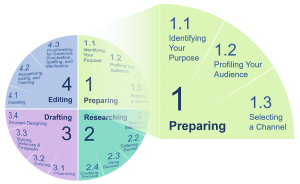Chapter 2: The Writing Process 1: Preparing
Learning Objectives
- Distinguish between general and specific purposes for writing.
- Analyze primary and secondary audiences using common audience-profiling techniques
- Identify techniques for adjusting writing style according to audience size, position relative to you, knowledge of your topic, and demographic.
- Write professional and discipline-specific documents that are clear, concise, correct, and visually engaging (ENL1004 Course Learning Outcome 1).
- Apply appropriate planning strategies to communicate purpose and message effectively (ENL1004 Course Learning Outcome 1.1).
- Distinguish between communication channels to determine which is most appropriate for particular situations.
Like communication in general, good writing comes from following a process. Between you hatching an idea and your audience reading and understanding that idea, the writing process enables the author to craft messages in a time-efficient manner that ultimately meets the needs of the audience. Without following the four-stage process of (1) preparing, (2) researching, (3) drafting, and (4) editing before sending a message (see Fig. 2 below), you may find yourself wasting your own time writing unnecessarily, as well as wasting your reader’s time by confusing them with a message that doesn’t make sense to them or meet their needs. The next four chapters in this textbook’s first unit deal with each of these four writing stages as if they were 15-minute segments of a clockface, dividing them further into several steps that, when followed as a matter of habit, can save you time by helping you write no more or less than what you need to in order to achieve your professional communication goals.

- 2.1: Knowing Your Purpose for Writing
- 2.2: Analyzing Your Audience
- 2.3: Selecting Appropriate Communication Channels

